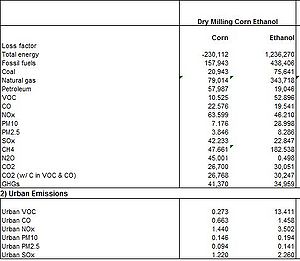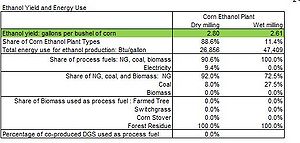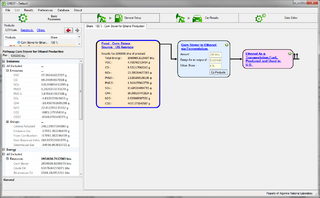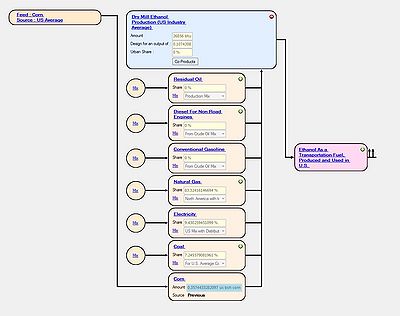Ethanol: Difference between revisions
Aelgowainy (talk | contribs) |
Aelgowainy (talk | contribs) |
||
| (13 intermediate revisions by the same user not shown) | |||
| Line 19: | Line 19: | ||
==Main Input== | ==Main Input== | ||
The "main" input refers to the initial amount of primary resource (main feedstock) | The "main" input in GREET refers to the initial amount of primary resource (main feedstock) used in the fuel's production pathway. For example the main input of corn-ethanol pathways would be corn. In the case of Compressed Natural Gas the main input would be natural gas in the well. More precisely, the main input represents the amount of main feedstock with energy equal to the energy in the unit fuel produced. The functional unit is typically 1 mmBtu of the fuel in GREET Excel. Both GREET Excel and GREET.net incorporate the "main" input into their life cycle calculations. However, the stage in which it is accounted for in each model is different. In the .net model, the energy in the main input is always added to the energy use by the first process in the pathway (the recovery of the main feed from its primary source in nature). However, this is not the case for GREET Excel. In GREET Excel, this energy in the main input (e.g., 1 mmBtu) is added in the vehcile operation stage of the life cycle of the fuel. The difference in accounting stage is a subtle issue since both models produce the same life-cycle results. | ||
In | |||
==Yields== | ==Yields== | ||
[[File:YieldsExcel.png|thumb|300px|]] | [[File:YieldsExcel.png|thumb|300px|]] | ||
The ETOH sheet utilizes yields to indicate the amount of product that can be produced from a certain amount of feed. For example | The ETOH sheet utilizes yields to indicate the amount of product that can be produced from a certain amount of feed. For example it indicates how much corn is used to produce a single gallon of Ethanol, or how much switchgrass is needed to produce a single gallon of ethanol fuel. Throughout the ETOH sheet corn, switchgrass, etc., data are calculated on a per bushel basis for corn and per ton of for other feedstock sources. GREET Excel shows how much energy is consumed and emissions are produced per bushel of feed harvested. However, in the subsequent process (i.e., ethanol production), the energy and emissions are calculated on a per gallon basis. The yield provides the conversion factor between these two functional units (i.e., per bushel of corn, and per gallon of ethanol). Screen shots of the ethanol yield from different feed sources in GREET Excel are shown below. They are primarily found in two tables. In the shown screenshot they are highlighted in green so that they can be easily identified. | ||
[[File:YieldsExcel1.png|400px|]] | [[File:YieldsExcel1.png|400px|]] | ||
In | In GREET.net these yields are used in a similar way. The "Feed" portion of data would be calculated on a per bushel basis, and then it is used as an input into a fuel production process which is based on a per gallon output. This is shown in the screenshot below. The yield value is in a text box highlighted in blue: | ||
[[File:YieldsDotNet.png|400px|Yields Utilized in Greet.net]] | [[File:YieldsDotNet.png|400px|Yields Utilized in Greet.net]] | ||
| Line 40: | Line 34: | ||
==Co-Products== | ==Co-Products== | ||
A co-product is something that is produced along side the main product. In both GREET.net and GREET Excel a co-product can provide energy and emissions credit if it displaces a product that conusmes energy and produces emissions. To calculate this credit the user selects the displaced product and the pathway for its production if the pathway is in GREET. Alternatively, the life cycle energy use and emissions associated with the displaced product can be specified to calculate the energy and emissions credits. If the co-product and displaced product are not the same, a displacement ratio has to be specified. For example, DGS can displace corn as an animal feed but the ratio is not necessary 1:1. It should be noted that the displacement calculations done in GREET.net accounts for the energy in the displaced material. The calculations for a co-product energy and credits are relatively straight forward. Below the credit calculations are shown for energy, but similar calculations can be done for emissions: | |||
<math>Enem_{credit}(f_p)=\,</math> | <math>Enem_{credit}(f_p)=\,</math> Energy and emissions credited to the co-product <math>f_p</math> | ||
<math> | <math>Enem(d)=\,</math> Energy and emissions associated with the production of the displaced product <math>d</math> | ||
<center> | <center> | ||
<math>Enem_{credit}(f_p) = | <math>Enem_{credit}(f_p) = Enem(d) \cdot Displacement Ratio\,</math> | ||
</center> | </center> | ||
The <math> | The <math> Enem (f_p)</math> is provided from the displaced product life cycle calculations and the displacement ratio is provided in GREET but can be changed by the user. For more information on how Co-Products are implemented in GREET.net refer to the [[Co-Products]] section of the wiki. | ||
Latest revision as of 22:06, March 21, 2012
Introduction/Preface
The implementation of the .net version of GREET required us to track the data and calculations in the ETOH sheet of the Excel version of GREET. The ETOH data sheet contains some calculations that are specific to the corn ethanol production and not common with other fuel production pathways in GREET. This includes fuel yield, land use changes, and co-product types and handling. The purpose of this document is to summarize these differences, and explain in details the execution of this portion in the .net model.
Feed & Fuel

In GREET excel, The energy and emissions results are split between "feed" & "fuel" in the summary tables for the fuel pathways at the bottom of each fuel recpective sheet. The energy and emissions allocated to the "fuel" in the summary tables refer to the energy and emissions associated with process fuels use in the production process (excluding the amount of the feed with energy equivalent to the energy in the produced fuel). The energy and emissions allocated to the "feed", or feedstock, refer to the energy and emissions associated with extracting, processing and transporting an amount of the feed (with energy content equivalent to the energy in the produced fuel) to the fuel production plant. In the case of Conventional Gasoline, crude is the feed. Examples of feed and fuel in GREET excel are shown in the table to the right.
In our implementation of GREET.net we do not split fuel from feed. We sum all our data on a life cycle basis. The final results we generate encompass both feed and fuel. However, a user of the GREET.net can easily obtain the energy and emission data pertaining to a certain process in the fuel life cycle. The upstream energy use and emissions are also provided in conjunction with each process results.
Below is a screen shot of Corn Stover to Ethanol pathway in GREET.net. The results shown to the left are for the final process in the pathway, which is the transportation process. Since this is the final process the results shown are for the entire life cycle for the ethanol fuel product. If a user is interested in the data up to the process immediately before the transportation process, the user can simply select that process (by pressing its icon), and GREET will show the results for the selected process, including the upstream processes all the way to the primary source of energy (main feedstock).
In addition it should be noted that at the beginning of the pathway their is a "Feed", representing Corn Stover in the above example. By hovering your mouse over the "Feed" it expands revealing the energy and emissions data associated with extracting, processing and transporting the amount of feed required for the production process (see screen shot below). By click the hyperlink in the "Feed: Corn Stover" frame, the pathways and processes associated with extracting, processing and transporting corn stover to the ethanol plant will be shown. Once again a user can click on any of these processes to view the energy use and emissions associated with these processes.
Main Input
The "main" input in GREET refers to the initial amount of primary resource (main feedstock) used in the fuel's production pathway. For example the main input of corn-ethanol pathways would be corn. In the case of Compressed Natural Gas the main input would be natural gas in the well. More precisely, the main input represents the amount of main feedstock with energy equal to the energy in the unit fuel produced. The functional unit is typically 1 mmBtu of the fuel in GREET Excel. Both GREET Excel and GREET.net incorporate the "main" input into their life cycle calculations. However, the stage in which it is accounted for in each model is different. In the .net model, the energy in the main input is always added to the energy use by the first process in the pathway (the recovery of the main feed from its primary source in nature). However, this is not the case for GREET Excel. In GREET Excel, this energy in the main input (e.g., 1 mmBtu) is added in the vehcile operation stage of the life cycle of the fuel. The difference in accounting stage is a subtle issue since both models produce the same life-cycle results.
Yields

The ETOH sheet utilizes yields to indicate the amount of product that can be produced from a certain amount of feed. For example it indicates how much corn is used to produce a single gallon of Ethanol, or how much switchgrass is needed to produce a single gallon of ethanol fuel. Throughout the ETOH sheet corn, switchgrass, etc., data are calculated on a per bushel basis for corn and per ton of for other feedstock sources. GREET Excel shows how much energy is consumed and emissions are produced per bushel of feed harvested. However, in the subsequent process (i.e., ethanol production), the energy and emissions are calculated on a per gallon basis. The yield provides the conversion factor between these two functional units (i.e., per bushel of corn, and per gallon of ethanol). Screen shots of the ethanol yield from different feed sources in GREET Excel are shown below. They are primarily found in two tables. In the shown screenshot they are highlighted in green so that they can be easily identified.
In GREET.net these yields are used in a similar way. The "Feed" portion of data would be calculated on a per bushel basis, and then it is used as an input into a fuel production process which is based on a per gallon output. This is shown in the screenshot below. The yield value is in a text box highlighted in blue:
Co-Products
A co-product is something that is produced along side the main product. In both GREET.net and GREET Excel a co-product can provide energy and emissions credit if it displaces a product that conusmes energy and produces emissions. To calculate this credit the user selects the displaced product and the pathway for its production if the pathway is in GREET. Alternatively, the life cycle energy use and emissions associated with the displaced product can be specified to calculate the energy and emissions credits. If the co-product and displaced product are not the same, a displacement ratio has to be specified. For example, DGS can displace corn as an animal feed but the ratio is not necessary 1:1. It should be noted that the displacement calculations done in GREET.net accounts for the energy in the displaced material. The calculations for a co-product energy and credits are relatively straight forward. Below the credit calculations are shown for energy, but similar calculations can be done for emissions:
Energy and emissions credited to the co-product
Energy and emissions associated with the production of the displaced product
The is provided from the displaced product life cycle calculations and the displacement ratio is provided in GREET but can be changed by the user. For more information on how Co-Products are implemented in GREET.net refer to the Co-Products section of the wiki.

